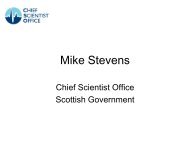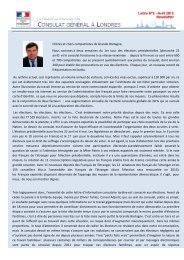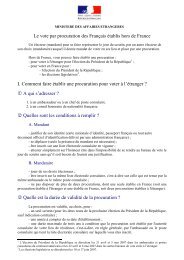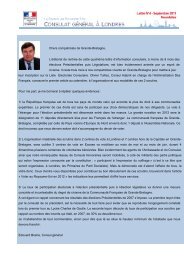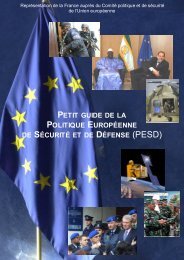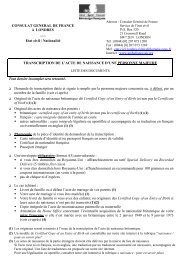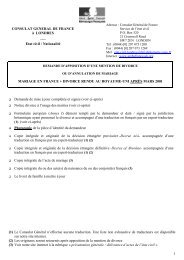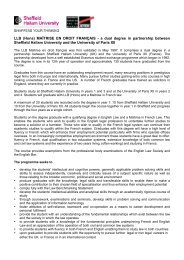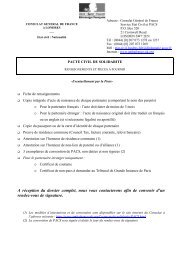Draft Outline For Responsible Innovation Workshop, April / May 2011
Draft Outline For Responsible Innovation Workshop, April / May 2011
Draft Outline For Responsible Innovation Workshop, April / May 2011
You also want an ePaper? Increase the reach of your titles
YUMPU automatically turns print PDFs into web optimized ePapers that Google loves.
Franco-British workshop on responsible innovation London, 23-24 <strong>May</strong> <strong>2011</strong><br />
International Association for Management of Technology), ‘<strong>Innovation</strong> and entrepreneurship’ and ‘High<br />
involvement innovation’ (all published by John Wiley and Sons).<br />
Daniel BLOCH<br />
Medical advisor for nanomaterials - CEA<br />
Daniel Bloch, MD, graduated at the Medical School of Paris V and specialized in occupational health and<br />
radioprotection. He served as an occupational physician at CEA, the French Commission for atomic energy and<br />
alternative energies, for more than 20 years, focusing in particular on chemical risk management in<br />
microelectronics research laboratories. In the early 2000s’, the rapidly growing CEA nanotechnology research<br />
activities led him to address HSE issues related to nanomaterials. In 2008, he was appointed CEA medical<br />
advisor for nanomaterials. He was part of the expert groups driven in 2006 and 2008 by the French Agency for<br />
Environmental and Occupational Safety (AFSSET, recently merged in ANSES) and dedicated to Nanomaterials<br />
and health & environmental issues. He now contributes to the IReSP (Institute for Public Health Research), the<br />
French Observatory for Micro and Nanotechnologies (OMNT), the European Observatory for NanoSafety<br />
(EONS) and the European program NanoImpactNet. He is also involved in standardisation, contributing to the<br />
work of HSE groups within AFNOR, CEN and ISO. He regularly gives lectures within the INSTN (National<br />
Institute for Nuclear Science and Technology, part of the CEA), a higher education institution, during training<br />
sessions for radioprotection an safety engineers.<br />
Jean-Pierre CHEVALIER<br />
Responsable, Département Ingénierie, Procédés et Sécurité - Agence Nationale de la Recherche<br />
Jean-Pierre Chevalier first read physics and then obtained a Ph.D. (1977) from the University of Cambridge. He<br />
then joined the Centre National de la Recherche Scientifique (CNRS) and was head of a major national<br />
metallurgy laboratory for over 12 years. He can probably be best described as a physicist working in the fields<br />
of metallurgy and materials science. He has extensive experience of electron microscopy of materials and,<br />
more specifically, has been involved in structural studies of disordered systems (metallic glasses and shortrange<br />
ordered alloys), heterogeneous materials (interfaces in semiconductors, metal-ceramic bonds,<br />
multilayers and other nanomaterials) and in structural studies of alloys. His recent interest lies in the analysis<br />
of materials requirements for sustainability (energy production, energy saving, reduction of CO 2 emissions and<br />
availability of mineral ressources). On leave from the CNRS, he was appointed to the chair of Industrial<br />
Materials at the Conservatoire National des Arts et Métiers in Paris in 2000. In 2009, he joined the Agence<br />
Nationale de la Recherche as head of the Engineering, Processes and Security department. He has authored<br />
over 100 scientific publications.<br />
Peter DOBSON<br />
Director of Oxford University’s Begbroke Science Park<br />
After a career as a lecturer in Physics at Imperial College and Senior Principal Scientist at Philips Research<br />
laboratories he was appointed to a University Lectureship and College Fellowship at the Queen’s College<br />
Oxford in 1988 and a Professorship in 1996. At Oxford his research moved into the areas of nanoparticles,<br />
nanostructures, optoelectronics and biosensors. In 1999 he spun-off a company, now called Oxonica plc, that<br />
specializes in making nanoparticles for a wide range of applications, ranging from sunscreens to fuel additive<br />
catalysts and bio-labels. In 2000, with colleagues in Chemistry and Engineering, he spun-off Oxford Biosensors<br />
Ltd that made a hand-held device based on enzyme-functionalized microelectrode arrays. He was appointed to<br />
his present position in August 2002 and has the responsibility of setting up new research institutes that<br />
combine University activities with company R&D, and leading a team that facilitates the rapid transfer of<br />
technology and knowledge. This has led to him being in demand internationally to advise on Knowledge<br />
Transfer. He consults widely and advises several corporate and national organizations on nanotechnology. His<br />
research interests are very broad, covering most aspects of nanotechnology, and embracing biotechnology,<br />
environmental technology, energy, materials science, especially the applications to medicine. He is also<br />
currently(2009-2012) the Strategic Advisor on Nanotechnology to the Research Councils in the UK.<br />
P J Dobson, BSc, MA (Oxon), PhD, C Phys, F Inst P, Member of the ACS.<br />
7



